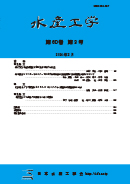
- Issue 3 Pages 95-
- Issue 2 Pages 53-
- Issue 1 Pages 1-
- |<
- <
- 1
- >
- >|
-
Hiroki Tamura, Yasunori Nihei2024Volume 60Issue 3 Pages 95-103
Published: February 15, 2024
Released on J-STAGE: March 14, 2024
JOURNAL FREE ACCESSOysters have been cultivated in Japan for a significant period of time, but the damage caused by typhoons has been a persistent problem. To address this issue, we studied the movement of Gros (oyster shell clumps attached to scallop) and hanging reams to identify the cause of typhoon-related damage. First, we constructed a Gro model and calculated the added mass coefficient and damping coefficient via a forced oscillation test. We also determined the drag coefficient from a drag test using the same model. Utilizing these coefficients as input parameters, we conducted a numerical analysis to study the behavior of the Gros and the hanging reams. In the numerical analysis, we subjected three hanging reams to waves, wind, and currents. We estimated the entanglement tendency of the hanging reams based on the distance between adjacent Gros. The results showed that the likelihood of entanglement of the hanging reams increased with a decrease in wave period for both regular and irregular waves. In addition, we discovered that the hanging reams’ entanglement was more likely when waves were incident in the direction where the chain was aligned.
View full abstractDownload PDF (1949K) -
Hideki Noro, Keiichi Uchida, Seiji Akiyama, Yoshinori Miyamoto, Tadash ...2024Volume 60Issue 3 Pages 104-116
Published: February 15, 2024
Released on J-STAGE: March 14, 2024
JOURNAL FREE ACCESSAn ultrasonic telemetry system was employed to monitor the bag net shape and volume of a large-scale set net off Oirase, Fukaura, Aomori Prefecture, during two fishing periods, namely May 15 to July 23, 2019, and May 18 to July 28, 2021. Two-dimensional electromagnetic current meters (logger version) were utilized to record the flow direction and velocity at three depths (10, 20, and 30 m) around the set net during the two fishing periods. The aim was to investigate the effect of water flow on the bag net shape and volume. The water flow direction around the set net was mostly toward the northeast, similar to the direction of the body net with respect to the bag net (46°NE). The flow around the bag net varied. Tidal currents did not significantly affect the flow. The water flow affected both the bag net shape and volume. The acoustic pingers on the bag net sometimes exhibited significant horizontal movement in addition to vertical movement. Generalized linear model analysis was used to express the bag net volume using flow components, with depth as a variable. The northeast flow component at a depth of 10 m increased the volume of the bag net, particularly in the fish-catching section, and that at depths of 20 and 30 m decreased the volume of the bag net.
View full abstractDownload PDF (6164K)
-
Ryogen Nambu, Terumasa Morishige2024Volume 60Issue 3 Pages 117-124
Published: February 15, 2024
Released on J-STAGE: March 14, 2024
JOURNAL FREE ACCESSIn this study, we compared the performance of two types of sediment bottom-samplers, this is, (1) the Light and Simple Bucket Type bottom-sampler (LSBT bottom-sampler) and (2) the Smith-McIntyre bottom-sampler (SM bottom-sampler). Experiments were conducted using identical buckets in a sand-filled circular tank in the laboratory. A sediment collection ratio of approximately 60.8% observed into the bucket using the SM bottom-sampler, and no significant difference was found in the sediment collection ratio between the man and woman groups. Of the LSBT bottom-sampler, the sediment collection ratios in the cases of lifting with vibration and without vibration were approximately 87.3%, and 55.2%, respectively. For the LSBT bottom-sampler, significant differences were found in the sediment collection ratio between the man and woman groups. Potentially, the increased speed in lifting the LSBT bottom-sampler affected sediment collection efficiency. For effective benthic surveys, it is sufficient to collect sediment volumes of greater than 2 L using a SM bottom-sampler with a size of 0.1 m2, which is equivalent to approximately 35% of the bucket capacity of a LSBT bottom-sampler. This implies that all methods compared in this study provided a sufficient volume for sediment collection. So, we believe that the LSBT bottom-sampler is a superior option for field surveys if the water depth, sample size, effort, and cost efficiency for sampling are considered.
View full abstractDownload PDF (842K)
-
Junji Kinoshita, Atsushi Minomiya, Hideaki Aikawa, Izuho Haruyama2024Volume 60Issue 3 Pages 125-130
Published: February 15, 2024
Released on J-STAGE: March 14, 2024
JOURNAL FREE ACCESSThe sporophytes of the warm temperate perennial kelp Ecklonia cava are known to mature from the second year. In some populations, however, thalli were recently suggested to mature within one year of germination in field observations, but the precocity was not directly confirmed in culture studies. In the present study, maturation rate of first-year sporophytes was examined for the first time. Free-living gametophytes were obtained from two wild populations in Moroiso and Jogashima Island, Miura Peninsula. The sporophytes derived from these populations were reared in a land-based tank (Exp. 1) or in open sea conditions (Exp. 2), respectively. The maturation rates of the sporophytes in the first year were 66% in Exp. 1 and 60% in Exp. 2. At the time of the maturation check, both stem diameter and total length were significantly larger in mature thalli than in immature ones (p<0.01, except total length in Exp. 1). Since the precocious thalli can mature earlier than the peak of browsing by herbivorous fishes (summer to autumn), they can be considered as candidates of a donor of zoospores to produce seedlings for restoration and expansion of the kelp beds.
View full abstractDownload PDF (1033K)
-
2024Volume 60Issue 3 Pages 131
Published: February 15, 2024
Released on J-STAGE: March 14, 2024
JOURNAL FREE ACCESSDownload PDF (85K)
- |<
- <
- 1
- >
- >|